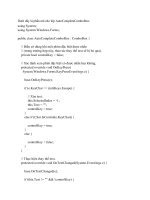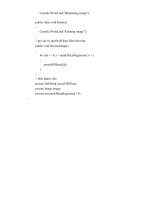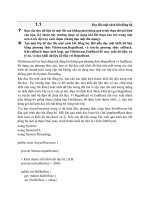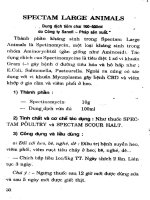.Object-Oriented Design for Temporal GIS Phần 3 docx
Bạn đang xem bản rút gọn của tài liệu. Xem và tải ngay bản đầy đủ của tài liệu tại đây (194.21 KB, 14 trang )
CONCEPTS OF SPACE AND TIME
15
Figure 2.3 (a) New Zealand in absolute space (b) New Zealand in 1953 time space (c) New
Zealand in 1970 time space. (Reprinted by permission of Oxford Press. Source Gatrell 1983,
p. 111)
Table 2.3 Main characteristics of the relative space-time view.
OBJECT-ORIENTED DESIGN FOR TEMPORAL GIS
16
2.7 CHOOSING THE VIEW FOR A GIS
Harvey argues that we ‘have (frequently) assumed a particular spatial language (i.e.
absolute view or relative view) to be appropriate without examining the rationale for
such a choice’ (Harvey, 1969, p. 161). After all, we should not discriminate one over
another. They are complementary. As Peuquet (1994) points out, the absolute view
requires some sort of measurements referenced to a constant base, implying non-
judgmental observation. The relative view, on the other hand, involves interpretation
of processes and the flux of changing patterns within a knowledge domain.
However, a question still remains about integrating absolute and relative views.
How can we have both perspectives placed in the same representation? Perhaps
the answer lies in time geography: ‘Owing to the circumstances under
which…[Time Geography] has been developed, its contents, and its applications
to date, there is a great danger that Hägerstrand’s time geographic framework
will be mistakenly construed as nothing more than a planning tool. On the
contrary,…the potential usefulness of the framework…is of much greater range’
(Pred, 1977, p. 213). Consequently, this book proposes that the concepts of Time
Geography should be exploited by GIS to capture the absolute space-time view as
well as the relative space-time view. The next section provides an overview of
Time Geography.
2.8 TIME GEOGRAPHY
The pioneering work of Torsten Hägerstrand during the 1960s unfolded the Time
Geography research that emerged from the Royal University of Lund in Sweden. The
concepts developed in time geography have been mostly consolidated in the work of
Hägerstrand and his students and collaborators Lenntorp, Mårtensson and Carlstein.
Pred (1977) provides an overview of the main uses of Time Geography in several
domains, among them domains concerned with regional development policies,
nationwide physical planning, and urbanisation and settlement policies. The Swedish
government has implemented many of the applications of Time Geography in order
to provide adequate job-market opportunities, and a satisfactory level of social and
cultural services. Some examples are the accessibility simulation of daily individual
activities in urban environments and regions (Lenntorp, 1978), comparative studies
of living conditions in different populated regions (Mårtensson, 1978), and analysis
of various activities in the quaternary sector, mainly concerned with employment
distribution (Olander and Carlstein, 1978).
Space and time in Time Geography are considered as orthogonal dimensions that
become fused into a space-time path representing the trajectory for the lifespan of an
entity (Figure 2.4). For simplification, as suggested by Hägerstrand, the
representation of space is along only one dimension to maintain the clarity of the
proposed representation framework and to give a better visualisation of the evolution
of public boundaries. The same simplification has been adopted for the time
dimension.
CONCEPTS OF SPACE AND TIME
17
Time is viewed as the dimensional axis that orders events, separates causes from
effects, and synchronises and integrates human activity (absolute time representation).
Space is viewed as the dimensional axis that represents the changes in the location of
an entity in space (absolute spatial representation). Space and time are joined in a
single space-time path. Space and time are considered inseparable within a path, and
it is the timing component which gives structure to space and thus evokes the notion
of place. Place is ‘a pause in movement’ (Parkes and Thrift, 1980, p. 120).
The Time Geography approach is an effort to capture the complexity of space-
time interaction at the scale of the smallest indivisible unit in space and time, i.e. the
space-time path (relative space-time view). However, by having space and time as
orthogonal dimensions, Time Geography requires the absolute view of space and
time. An absolute location in the space axis and an absolute location in the time axis
are needed to define a place on a space-time path. The absolute location in the space
axis may be determined with reference to a coordinate system, whereas the absolute
location in the time axis may refer to location in time derived from a clock or calendar.
A space-time path provides the starting time, the duration, the frequency, the sequential
order, as well as the relative location of events and changes that have occurred in a
lifespan of an entity.
The continuous line of a space-time path is the relative space-time representation
of the lifespan of an entity. It is a descriptive form to reveal the interdependence and
relationships between events and changes (Lenntorp, 1976). ‘Space and time are to
be jointly treated…because when events are seen located together in a block of space-
time [paths], they inevitably expose relations which cannot be traced if those events
are bunched into classes and drawn out of their place in the block, i.e., conventionally
analyzed’ (Pred, 1977, p. 210).
Figure 2.4 Space-time paths of three entities
OBJECT-ORIENTED DESIGN FOR TEMPORAL GIS
18
The sense of past, present and future depends on where the observer is placed in
the space-time path. The observer has the awareness of coexistence (connection or
togetherness) relationships between space and time at every place located in a space-
time path (Hägerstrand, 1975). The motion of an observer can be limited to a set of
circumstances described by the constraints which have been defined for a space-
time path. Called the potential path areas (Figure 2.5), this set is represented as a
prism in Time Geography. It comprises space-time positions for which the possibility
of being included in the observer’s trajectory is greater than zero (Lenntorp, 1976).
A general procedure cannot be developed for deriving or calculating potential path
areas from empirical data. Each knowledge domain has to be analysed in order to
generate its actual potential path areas.
Figure 2.5 An example of potential path areas. (Reprinted with permission from Parkes and
Thrift, 1980, John Wiley & Sons Ltd)
CONCEPTS OF SPACE AND TIME
19
2.9 TIME GEOGRAPHY AND GIS
Although Time Geography is an effective approach to dealing with space and time in
an integrated manner within a GIS, it has so far been neglected. After analysing the
feasibility of handling space-time concepts of Time Geography within a GIS, Miller
affirms that ‘Geographic Information Systems, through their ability to manipulate
and analyse spatial data, can allow more widespread use of the space-time perspective
[of Time Geography] in spatial modelling and analysis’ (1991, p. 300).
Few examples are available for illustrating the attempts at applying the Time
Geography approach within a GIS. Miller (1991) has generated potential path areas
(PPAs) for a transportation network application on the basis of arcs in the network
that are feasible to travel. The mainframe version 5.0 of ARC/INFO was used for the
implementation in order to handle a set of nodes and arcs, keep records of locations
within the system, and handle numerous travel times at both nodes and arcs in the
network. Although ‘ARC/INFO NETWORK can meet the requirements for standard
GIS applications; it is inefficient and unwieldy in meeting the more specialised needs
of the network PPA procedure. Whereas ARC/INFO is certainly not representative of
all GIS software, it does provide a benchmark which indicates the problems
encountered by analysts who wish to use GIS technology in more specialized research
and modelling’ (Miller, 1991, p. 299).
Miller also points out the main requirements in applying Time Geography in
a GIS:
< The Time Geography approach requires data at a detailed spatial scale in order to
obtain an effective analysis in a GIS.
< The GIS must be able to address the behavioural aspects of data to generate more
realistic operational PPAs.
< The favoured GIS to implement a time geographic framework must be able to
store and manipulate topological relationships to avoid adding unnecessary
complexity to the framework.
< The derivation and manipulation of PPAs in a GIS might be accomplished by
developing the framework to support space and time constraints. A modular
structure with inflexibility of key commands and procedures can render a GIS
unable to derive the desired space-time prism framework.
Another example is the application of Time Geography for simulating an individual’s
daily shopping behaviour within a GIS (Makin, 1992). The results show how time
and space constraints on people’s shopping movements affect shops’ potential earnings
and profits. Makin explores the potential of using a GIS to structure spatial relationships
according to which routes are accessible to each other, and where the buildings are
located on the route network.
He also points out the potential benefits of having implemented his Time Geography
model into Smallworld GIS for simulating the behaviour of people’s movements:
OBJECT-ORIENTED DESIGN FOR TEMPORAL GIS
20
< The data items are not generalised or aggregated within the GIS.
< The entities are allowed to move and interact with their constraints in space and
time in a way that long-term behavioural patterns can be analysed.
< The model is expressed in terms that do not require abstraction into mathematics.
< The whole system can be organised in a modular fashion in which subsystems
are created for reducing the complexity of the model by minimising the amount
of data and the number of interactions.
These two examples illustrate the potential perspectives of applying Time Geography
in a GIS. And Time Geography could be used to formulate space-time semantic
abstractions in the design of a spatio-temporal model based on the object-oriented
approach—something not thoroughly explored until now.
2.10 MAIN ELEMENTS OF A SPACE-TIME PATH
Space-time paths can be defined as image schemata that directly depict the lifespan
of each singular entity in a knowledge domain. The space-time path is based on the
fact that an observer can move anywhere along the space-time path, there is a starting
location (in space and time), a direction (motion, change), and a sequence of
continuous locations (in space and time) that the observer goes across in following
the path. The space-time path embodies the structures of identity, location (in space
and time) and direction that are the basic abstract metaphors for modelling spatio-
temporal data in GIS.
Langran (1992b) asserts there are at least three sorts of spatio-temporal data in
GIS: states, events and evidence. In extending this classification, Kraak and
MacEachren (1994) point out a further differentiation between events and episodes.
In essence, a state represents a version of what we know about an entity in a given
moment. States can consist of different versions of an individual entity (the changes
of an individual political boundary marking the variation on the distribution of a
territory and its sovereignty) or an ensemble of entities (the changes in ecosystem
conditions produced by reductions in atmospheric emissions of pollutants). An event
is the moment in time an occurrence takes place. Events cause one state to change to
another (e.g. a cadastral survey may take place due to changes on properties’
boundaries). Events are also part of a process of change caused by action and reaction
as well as the synthesis of both (e.g. the process of energy propagation and ozone
hole formation). An episode is defined as the length of time during which change
occurs, a state exists, or an event lasts. And finally, a piece of evidence is the datum
describing the source of state and event data. No evidence should ever be stored in a
GIS without referencing its source document, survey or update procedure.
This book proposes the space-time paths as ideal image schemata for representing
and organising the spatio-temporal data categories in GIS (state, event, episode and
evidence). The aim is a better understanding of the defined categories by distinguishing
the three main structures of a space-time path: identity, location and direction. Any
CONCEPTS OF SPACE AND TIME
21
knowledge domain contains a population made up of entities which are represented
in the Time Geography as point objects. A singular space-time path describes a lifespan
trajectory through time over space, from the point when and where the entity comes
into being, to the point when and where the entity ceases to be. As a result, a singular
space-time path must exist provided an entity exists. However, it does not necessarily
mean that a space-time path must have a longitudinal linear configuration. On the
contrary, space-time paths can have either longitudinal or branching configurations
(Figure 2.6).
Longitudinal configurations imply there is no possibility of having two or more
directions over the past or future during a lifespan of an entity. They also imply that
the exact spatial location of an entity is known at all times. Most cases of short-term
changes making up the history of day-to-day occurrences of an entity portray
longitudinal space-time paths. Examples are transport maintenance of state roadways,
public works of utility companies, and cadastral measurements. On the other hand,
branching configurations are encountered in medium-and long-term changes in the
lifespan of an entity. Examples are the effects of pollution given various climatic and
economic scenarios, accident and disease patterns, and land use and demographic
trends.
Each space-time path is in fact the spatio-temporal signature of any entity in a
knowledge domain. And as such, it has the ability to reveal the connections and
interrelations among different entities. The identity, location and direction of a space-
time path are fundamental structures to connect and interrelate the spatio-temporal
data categories (state, event, episode and evidence). The following sections describe
how this can be achieved.
2.10.1 State as an element of the space-time path
A state can be depicted as a specific location in the space axis, illustrated here using
two dimensions for clarity. In the lifespan of an entity, changes occur in its space-time
path describing the evolution of its inner existence, or a mutation of its location in
space. Historical evolution regards change as the adaptation of an entity to its
Figure 2.6 Possible configurations for a space-time path
OBJECT-ORIENTED DESIGN FOR TEMPORAL GIS
22
environment by the process of differentiation and increasing structural complexity
(Figure 2.7(a)). Mutation relates change to the theory of revolution, emphasising the
importance of conflict or struggle as the principal mechanism of change. It characterises
any alteration in the direction of the space-time path, hence the change of its location
in space (Figure 2.7(b)).
States tend to represent the short-term changes which can occur during the lifespan
of entities. Such changes can occur due to man-made alteration in the position of
entities on the ground. In contrast, states can also be related to the long-term and
medium-term changes such as environmental changes. Changes can also occur due to
natural causes, and the most common example is displacement of watercourse for
rivers and streams. In any of these cases the spatio-temporal path gives the co-location
of changes in space and time, as illustrated in Figure 2.8.
2.10.2 Event as an element of the space-time path
Those familiar with event-oriented representation and update-oriented representation
should not mistake the concept of event in Time Geography. Both representations
Figure 2.7 Examples of states as elements of the space-time path
Figure 2.8 Co-location in space
CONCEPTS OF SPACE AND TIME
23
have been discussed as pragmatic solutions for representing spatio-temporal data in
GIS (Langran, 1993). In an event-oriented representation, events are described by the
moments of change. Only the events accountable for some sort of change over a state
of an entity are represented. The occurrence of an event always causes the creation of
a new version from a previous state of an entity. Conversely, in an update-oriented
representation, events are related to the occurrence of updates of the data stored in a
GIS. The lifespan of an entity is represented by a sequence of events that represent the
occurrence of all kinds of updates, even those updates that are not accountable for
any change in the state of this entity. These updates usually constitute a resurvey of an
entire region, regardless of where or what change has occurred. Photogrammetric
and remote sensing surveys are examples of collection-driven updates that are
scheduled to occur in a given time interval.
A different perspective in representing events is found in the space-time path
described in Time Geography. Events are not necessarily related to the creation of
versions (states) or update activities in GIS. Time Geography emphasises the need for
understanding geographic processes in which the mechanisms of change as well as
the patterns of change have to be analysed through time. The sequence of events
through time is viewed as the spatio-temporal manifestation of certain processes. The
space-time path provides the connection, ordering and synchronisation of events, and
their association with the respective changes (states) if they have occurred over a
lifespan of an entity (Figure 2.9).
In placing events in the time axis of a space-time path, the meaning of an existence
and mutation is given to a lifespan of an entity. Each space-time path captures the
spatial and temporal sequence and coexistence of events. An ensemble of space-time
paths belonging to several different entities can also represent the interaction among
these entities. Such an interaction is given by the co-location of events in time (Figure
2.10). GIS can be used to keep the record of ‘co-location of events’ of space-time
paths of a number of entities. The outcome is a web formed by the interrelations of
individual trajectories of several space-time paths. Such a web can uncover processes
Figure 2.9 (a) The space-time shows a sequence of events that have occurred over the lifespan
of an entity without causing any change in the spatial location of this entity, (b) The space-time
path shows the ordering of the events and their respective associated changes over the spatial
location of an entity
OBJECT-ORIENTED DESIGN FOR TEMPORAL GIS
24
that are responsible for the ‘temporal connectedness’ of common existence in time.
Hägerstrand (1975) has previously named these processes as ‘collateral processes’—
processes which do not unfold independently but are observed from their common
existence in time.
2.10.3 Episode as an element of the space-time path
An episode is defined as the length of time during which change occurs, a state exists
or an event lasts. The length of the space-time path and its angularity with the time
axis are important in classifying changes according to their respective duration: the
larger the angle, the shorter the duration. Three main types of change can be
characterised in a space-time path (Parkes and Thrift, 1980):
< Long-term changes modifying the environment
< Medium-term changes transforming cultures
< Short-term changes making up the history of day-to-day incidents
2.10.4 Evidence as an element of the space-time path
An entity is represented as a point object in Time Geography. Evidence is the data
about entities, events and states that have occurred. Each place on the space-time path
can only exist if there is a state associated with that place and evidence to confirm an
event occurred (Figure 2.11). The space and time axes will determine the scale in
which a space-time path occurs. In practice this is determined by the spatio-temporal
data collected for a GIS.
2.11 UNCOVERING SPACE-TIME PATHS
The possibilities of defining the events, states and episodes that belong to a space-
time path are immense for any knowledge domain in geographic information sciences.
Figure 2.10 Co-location in time
CONCEPTS OF SPACE AND TIME
25
Consequently, a space-time path can be constructed according to an ensemble of
constraints which define the circumstances what, where and when over space and
time. These constraints operate on entities, events and states depending on a set of
circumstances linked to the individual entity and its environment. This involves spatio-
temporal data modelling of the behaviour of space-time paths.
Three types of constraint are described in Time Geography (Hägersrrand, 1975)
and can be used in designing the spatio-temporal data model:
< Capability constraints limit the trajectories of the space-time paths. Space has a
limited capacity to accommodate events because entities cannot occupy the same
space at the same time, and every entity has a geometric boundary in space.
Therefore every space has a packing capacity defined by the types of entities to
be packed into it. Some constraints have a predominant time factor, at rather
strictly regular intervals. Others can have a dominant space factor, forming
bounded regions or volumes.
< Coupling constraints define where, when and for how long the events and states
have to join a space-time path of an entity. Coupling constraints can reveal the
pattern of space-time paths by exhibiting prism, area or volume configurations
known as the potential path areas (PPAs).
< Authority constraints impose restricted access to space-time paths. The main
purpose of defining authority constraints is to organise access to the data as well
as to define domains of authority. In Time Geography the domain of authority is
shown as a cylinder (Figure 2.5).
2.12 CONCLUSIONS
This chapter has focused on the main concepts of time geography. Many references
in the literature introduce the Time Geography approach and its possible applications.
The reader interested in an expanded coverage of these topics can find a good start
with Hall (1966), Karlqvist, Lunqvist and Snickars (1975), Lenntorp (1976), Pred
Figure 2.11 Evidence as an element of the space-time path
OBJECT-ORIENTED DESIGN FOR TEMPORAL GIS
26
(1977), Carlstein, Parkes and Thrift (1978), Parkes and Thrift (1980) and Golledge
and Stimson (1997).
The main concepts of Time Geography discussed in this chapter play an important
role in the design of spatio-temporal data models in GIS. Time Geography is not just
another theoretical framework but it discloses how the integration between the absolute
and relative views of space and time can be devised in GIS. Besides, the whole rationale
of the Time Geography approach is the inseparability of space and time. In other
words, states, events, episodes and evidence are all interrelated and connected through
a space-time path of an entity. The space-time paths provide the image schemata for
modelling spatio-temporal data of a knowledge domain in GIS. Very little information
is available in the published literature on using time geography with GIS. This chapter
has described two efforts made in this area, Miller (1991) and Makin (1992).
The semantics of states, events, episodes and evidence used in this chapter, in
order to describe a space-time path, were not related to any particular level of
abstraction, be it geographic (nation, region, centre), temporal (year, month, day) or
demographic (population, group, individual). The purpose was to provide suitable
semantics for modelling spatio-temporal data at multi-scales in space and time; readers
may then adapt them to their specific knowledge domains. A practical example will
be given in Chapter 5 to show how these semantics can be applied and implemented
into a spatio-temporal data model based on knowledge domain areas such as historical
geography.
The usefulness of Time Geography lies in providing space-time semantics to object-
oriented analysis and design of spatio-temporal data models in GIS. Chapter 3 considers
the concepts behind the object-oriented approach.
27
CHAPTER THREE
Object-oriented
analysis and design
Object-oriented methods cover methods for design and methods for analysis.
Sometimes there is an overlap, and it is really an idealization to say that they are
completely separate activities. I.Graham, Object-Oriented Methods
This chapter provides a historical background to object-oriented data management,
illustrating the diverse efforts involved in object-oriented methods, temporal databases
and version management approaches. It helps to explain the main concepts in the
object-oriented paradigm that are essential for developing a spatio-temporal data model.
A historical background on object orientation summarises the chronological
developments from object-oriented programming languages to object-oriented design
methods, and finally to object-oriented analysis methods. It can be difficult to choose
which object-oriented method to apply in a spatio-temporal data model. For integrating
the time geography framework within our spatio-temporal data model, the object-
oriented analysis and design method proposed by Booch (1986, 1991, 1994) is
presented as the best in terms of notation, completeness and technique.
The temporal database research is reviewed on the basis of concepts and techniques
developed to establish appropriate temporal data management support for a spatio-
temporal data model. Version management approaches are then described, emphasising
approaches for ordering and updating versions within a model. The version
management approach should be chosen so it can be effectively integrated with the
spatio-temporal data model. In our spatio-temporal data model, versions are deemed
to be distinct from snapshot series because they represent states that belong to the
space-time path of an entity.
3.1 HISTORY OF THE OBJECT-ORIENTED PARADIGM
The history of object orientation starts in the early 1960s with the efforts of Dahl,
Myrhaug and Nygaard in creating and implementing new concepts for programming
OBJECT-ORIENTED DESIGN FOR TEMPORAL GIS
28
discrete simulation applications. By 1965 the object-oriented programming language
Simula (Dahl and Nygaard, 1966) had been developed on the basis of the ALGOL-60
language, which was specifically oriented towards discrete event simulation. Later, in
1967, the same Norwegian team developed the programming language Simula-67 (Dahl,
Myrhaug and Nygaard, 1968), once again an extension of ALGOL-60. It is with Simula-
67 that the basic concepts which characterise existing object-oriented programming
languages were first introduced. In particular, Simula-67 introduced the notion of an
object class defined by its type and the algorithms necessary to its manipulation. It
also introduced the inheritance mechanisms through which an object class could inherit
the data and the algorithms from other object classes.
However, it was only after the mid-1970s that the concepts introduced by Simula-
67 were widely recognised. The programming language Smalltalk, a result of the
work accomplished by Kay, Goldberg, Ingals and others at the Xerox Research Center
at Palo Alto (PARC), has become established as the purest representation of object-
oriented concepts. In Smalltalk everything is perceived as an object, and objects
communicate with each other by passing messages. Having its origins in Simula and
the doctoral research work of Alan Kay, Smalltalk has evolved by integrating the
notion of classes and inheritance from Simula as well as the functional abstractions
flavour of LISP.
1
There have been five releases of Smalltalk running from Smalltalk-72, launched in
1972, to Smalltalk-80, launched in 1980; the other three releases were launched in
1974, 1976 and 1980. Smalltalk-V and Smalltalk-AT have also been created as dialects
from the former Smalltalk developments (Krasner, 1981). Generally, Smalltalk is a
complete programming environment, having features such as editors, a class hierarchy,
browsers and many of the features of a fourth-generation language (Graham, 1994).
Booch puts it like this:
Next to Simula, Smalltalk is perhaps the most important object-oriented programming
language, because its concepts have influenced not only the design of almost every
subsequent object-oriented programming language, but also the look and feel of
graphic user interfaces such as the Macintosh user interface and Motif.
(Booch, 1994, p. 474)
Several object-oriented programming languages have been developed, most of them
having their conceptual foundations based on Smalltalk. These attempts have tried to
overcome the main inefficiency problems of Smalltalk (e.g. the lack of support for
persistent objects and unfeasibility of having a distributed multi-user environment)
but with the pitfall of compromising the purity and consistency of Smalltalk’s features.
Over 100 object-oriented programming languages have been developed in the past
decade. However, as Stroustrup points out: ‘One language is not necessarily better
than another because it has a feature the other does not—there are many examples to
the contrary. The important issue is not how many features a language as, but that the
1
LISP stands for list processing; it was originally developed by John McCarthy in 1958 and more recently
it has been used in artificial intelligence work.









